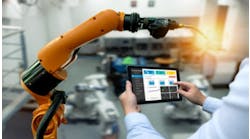How to eliminate manufacturing exceptions with an intelligent collaborative mechanism
By Caitlyn Caggia, systems integrator/solutions architect and content writer for PDF Electric & Supply
Modern manufacturers must adapt quickly to changing customer requests and market
PDF Electric & Supply's Caitlyn Caggia
demands. Fixed-position assembly systems are highly sensitive to exceptions, and even minor interruptions can significantly impact response time and drive up costs. To avoid exceptions, researchers are investigating dynamic scheduling theories and applications.
Dynamic scheduling
Although manufacturers strive to optimize their planned schedules, many real-time events are difficult to predict. In the context of assembly systems, real-time events can be classified as either resource-related (e.g. machine maintenance, operator unavailability, or defective materials) or job-related (e.g. due-date change or job cancellations). Based on the way these events are handled, dynamic scheduling strategies are grouped into three categories:
-
Completely reactive scheduling follows a sequence of predetermined rules to generate a new solution on the spot.
-
Predictive–reactive (robust) scheduling, the most popular approach, enables low-effort adjustments for simple schedule changes, but may reduce the overall efficiency of the assembly process.
-
Robust proactive scheduling offers room for innovation, as this strategy can improve both stability and general system performance once robustness metrics are identified and defined.
Across all three strategies, interruptions on fixed-position “islands” tend to be highly localized, and information is segmented by various stages and operators. To accurately predict, prevent, or mitigate interruptions, a holistic view of all real-time global system information is required. For robust proactive scheduling, even more data collection is necessary to accurately track additional details on the status and response of assembly processes.
Training traditional models can be incredibly time intensive, and rely on domain knowledge and management expertise, which can compound error, as management is restricted by their inability to rapidly collect, process and analyze data; in particular, management struggles for situational awareness between manual-operator effort and disjointed automated processes. Research has focused on creating “smart” dynamic scheduling systems that incorporate large amounts of disparate real-time data to make intelligent decisions.
Intelligent collaborative mechanisms
Technical advances in the IIoT, cloud computing, and machine learning have accelerated development of real-time big data systems. These innovations can work together to create a cohesive image of the entire manufacturing process and can rapidly reoptimize schedules based on historical and predicted data. An Intelligent Collaborative Mechanism (ICM) guarantees intercommunication between resources using IoT, and it reprioritizes tasks and division of labor using advanced computing methods. Consider this four-layered structure for operationalizing intelligent collaboration...
Layer 1: Real-time data collection from sensors
Smart sensors gather and integrate real-time data to provide a complete representation of the assembly process by tracking location and status of tools, materials, subassemblies and operators. These sensors share information among each other and into additional ICM layers using bluetooth, WIFI or RFID. Data-collection frequency can be reduced from instantaneous flows of information to snapshots at discrete intervals, reducing data storage, transmission and processing costs.
Layer 2: Production monitoring and exception identification
Data from individual sensors is integrated into larger assembly-status indicators, like a change-in-state of a tool or the completion of a group of tasks across multiple assembly stations. Aggregated sensor data is compared against planned schedules to determine if an exception has (or will) occur. Once an exception has been identified or predicted, various rescheduling plans will be generated using Petri nets to prioritize the most critical events.
Layer 3: Resource modeling and task preselection
Tasks are assigned to resources based on current job/material status from sensors in Layer 1 and changes in the event queue from exception monitoring from Layer 2. Decisions are made based on the most recent data, rather than prerequisite performance—operators and tools are assessed based on their recent performance and upcoming availability. These unconstrained tasks are preselected to resources to simplify and streamline real-time rescheduling. Neural networks can continuously refine the task preselection parameters of the ICM, improving long-term performance and efficiency.
Layer 4: Collaborative task-resource matching
Tasks that cannot be preselected are dynamically assigned to resources. Tasks are prioritized based on their urgency, process order, average assembly time, or other metrics. The initial production plan is modified in accordance with real-time system status, progress of related processes, and priority of dynamically assigned tasks. This maintains the integrity of the initial optimized plan (where possible) and accommodates exceptions with minimal interruptions.
Remaining challenges
Although ICM has proven its ability to seamlessly adapt fixed-position assembly processes to mitigate exceptions, there are several remaining practical challenges for researchers and engineers:
-
Process complexity: In practice, fixed-assembly products tend to be highly complex and involve many tools, resources and processes. More rigorous use cases need to be applied to ICM to improve flexibility and efficiency across an intensive assembly sequence.
-
Varied processes: Many industries and products require fixed assembly. The existing test cases for ICM have been relatively narrow in scope, raising concerns when transferring this theory to broader practical applications.
-
Algorithm maturity: Basic optimization algorithms used in initial evaluations of ICM restrict the rate and accuracy of task matching. Modern techniques, like federated computing or genetic algorithms, can optimize tradeoffs between efficiency and effectiveness in dynamic task-matching.
ICM presents a promising application of dynamic scheduling, but further research is needed to scale and scope this methodology to practical fixed-position assemblies.



